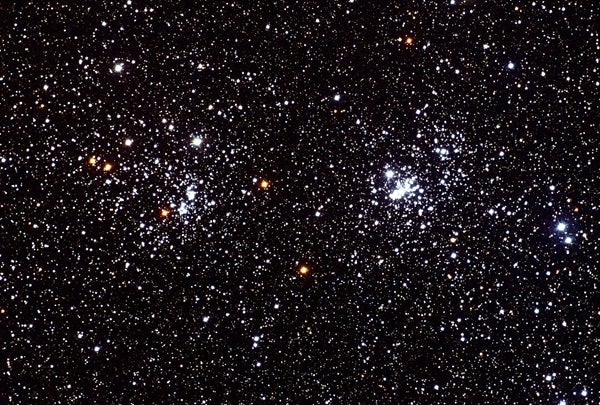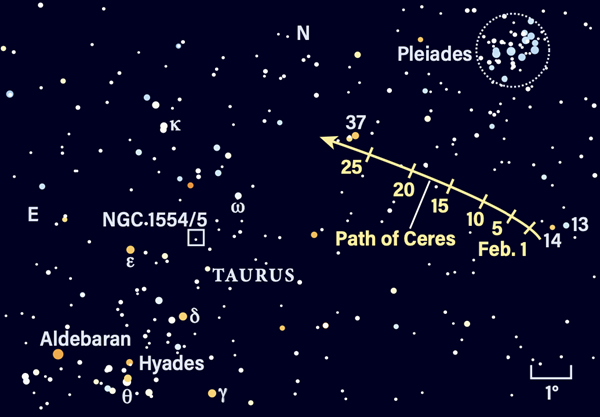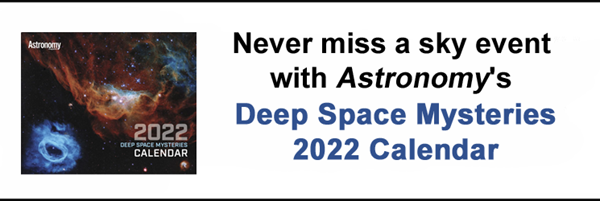Friday, February 4
Saturn is in conjunction with the Sun at 2 P.M. EST, rendering it invisible for now. It will reappear in the morning sky near Mercury by the end of the month
Comet 19P/Borrelly is classified as a Jupiter-family comet whose 6.9-year orbit takes it from inside the orbit of Mars to beyond the orbit of Jupiter. The comet is currently magnitude 9 and beginning to fade as it heads out and away from the Sun after reaching perihelion a few days ago. Tonight this comet shares the constellation Pisces with a thin crescent Moon.
To find Borrelly, locate 4th-magnitude Alrescha in far eastern Pisces. Once you’re there, skim a little less than 8° northeast to land on Borrelly. Larger apertures and darker skies will really help you here: An 8-inch telescope with 150x magnification under dark skies should easily show the comet’s fuzzy coma. If you have a smaller scope or are observing under less ideal conditions, be patient and scan the area slowly.
Borrelly will continue to fade throughout the month but passes some interesting targets along the way. Keep checking back for more observing information as February progresses.
Sunrise: 7:06 A.M.
Sunset: 5:23 P.M.
Moonrise: 9:22 A.M.
Moonset: 9:27 P.M.
Moon Phase: Waxing crescent (15%)
*Times for sunrise, sunset, moonrise, and moonset are given in local time from 40° N 90° W. The Moon’s illumination is given at 12 P.M. local time from the same location.
Saturday, February 5
Asteroid 20 Massalia reaches opposition at 3 A.M. EST. This 90-mile-wide (145 km) main-belt world lies in Cancer, just over 9° east-southeast of the easy-to-spot, naked-eye Beehive Cluster (M44). Massalia currently glows at magnitude 8.5 and can be picked up with binoculars or a small scope, particularly from a dark site. By 4 A.M. local time, it’s still 35° high; it will slowly set as the sky eventually grows lighter.
Before dawn, though, there’s a meetup you won’t want to miss: Mars sits a mere 0.2° north of the core of globular cluster M22 this morning. They rise around 5 A.M. local time — shortly before sunrise, so you’ll need to be quick with your binoculars or scope to catch them in the southeastern sky. They’re just 4.5° high by 5:30 A.M. The Red Planet shines at magnitude 1.4, while the fuzzy sphere of M22 is magnitude 5.1 and will need optical aid to capture in the brightening twilight. It’s an excellent setup for a stunning astrophoto.
Sunrise: 7:04 A.M.
Sunset: 5:24 P.M.
Moonrise: 9:46 A.M.
Moonset: 10:31 P.M.
Moon Phase: Waxing crescent (24%)
Sunday, February 6
Mercury is now visible in the morning sky, some 3° high in the east an hour before sunrise and glowing at magnitude 0.4. It sits to the left of the handle in Sagittarius’ Teapot asterism. To its upper right are Venus and Mars. Venus steals the show at a bright magnitude –4.9, located 13° west of Mercury and 10.5° north of the Teapot’s handle. Mars, still magnitude 1.4, sits just over 3° east of 3rd-magnitude Kaus Borealis, the tip of the Teapot’s lid.
Through a telescope, Venus is a mere 20 percent lit but spans an appreciable 45″. By contrast, Mercury’s tiny disk appears just 8″ across but is slightly fatter at 37 percent lit. The inner planets will remain at roughly the same altitude throughout the month, while Mars tracks northeast at a faster rate.
Sunrise: 7:03 A.M.
Sunset: 5:26 P.M.
Moonrise: 10:09 A.M.
Moonset: 11:34 P.M.
Moon Phase: Waxing crescent (33%)
Monday, February 7
The Moon passes 1.2° south of Uranus at 3 P.M. EST. You can catch them in the evening sky, now just over 2° apart and floating in southern Aries the Ram.
The Moon and Uranus are located midway between Menkar in Cetus and Hamal in Aries. Aries itself has few bright stars, which reside in the northeastern portion of the constellation. Instead, it might be better to look to the upper left (northwest) of the head of Cetus the Whale, which currently sits below Aries on the sky. The Moon-Uranus pair is just 4.5° north of 4th-magnitude Mu (μ) Ceti.
The Moon is nearly 7 days old and 45 percent lit, showing off its eastern limb. Uranus sits to our satellite’s northwest and glows at magnitude 5.8, dim enough that you’ll want binoculars or a telescope to pick it up. Its disk will appear as a 4″-wide, “flat” star
Sunrise: 7:02 A.M.
Sunset: 5:27 P.M.
Moonrise: 10:34 A.M.
Moonset: —
Moon Phase: Waxing crescent (42%)
Tuesday, February 8
First Quarter Moon occurs at 8:50 A.M. EST. Tonight, our satellite sits just inside the border of Taurus, having crossed there from Aries. It floats nearly 7° southwest of the Pleiades star cluster (M45) and nearly 14° west of the Hyades cluster.
Look above Taurus tonight and you’ll find the star figure of Perseus the Hero. This constellation houses a stunning pair of open clusters, cataloged as NGC 869 and NGC 884 or h and Chi (χ) Persei, respectively. Collectively called the Perseus Double Cluster, the two sit roughly 0.5° apart, with Chi Persei lying east of h Persei. At their distance of 7,000 light-years from Earth, they are physically less than 100 light-years apart. You should be able to get them both in a single low-power field of view. If your telescope is still too powerful, try looking through its finder scope.
Sunrise: 7:01 A.M.
Sunset: 5:28 P.M.
Moonrise: 11:00 A.M.
Moonset: 12:36 A.M.
Moon Phase: Waxing gibbous (52%)
Wednesday, February 9
The Moon, still in Taurus, passes 0.03° north of dwarf planet 1 Ceres at 6 A.M. EST. Both are invisible at that time, but by sunset tonight, this region is already high in the southeastern sky. Wait for dark, then look about 7° west of the Moon to find Ceres, which glows at magnitude 8.6 and will require binoculars or a telescope to pick out.
Ceres is the largest object in the asteroid belt, spanning nearly 600 miles (965 km) and comprising 25 percent of the mass in the main belt. Its orbit takes it around the Sun once every 4.6 years, while the tiny world spins on its axis every 9 hours. Ceres will spend the entire month in Taurus, slowly sliding northeast below the Pleiades. This is a good time to track the world’s motion, as the dark clouds of dust scattered across this region of sky help to blot out some of the Milky Way’s myriad stars. This week, Ceres is nearly alone within a single telescopic field of view a few degrees northeast of a bright pair of stars, 13 and 14 Tauri.
Sunrise: 7:00 A.M.
Sunset: 5:29 P.M.
Moonrise: 11:31 A.M.
Moonset: 1:38 A.M.
Moon Phase: Waxing gibbous (61%)
Thursday February 10
Draco the Dragon snakes his way above the North Celestial Pole this morning. One of the 10 largest constellations in the official list of 88, Draco contains several excellent deep-sky targets to look for once the Moon sets early this morning.
First, locate 3rd-magnitude Iota (ι) Draconis. Look 4° southwest of this star and you’ll alight upon M102, also known as the Spindle Galaxy. Some 50 million light-years away, this galaxy spans 4.5′ by 2′ on the sky — but in reality, it stretches about 60,000 light-years across. It’s magnitude 10, which is faint enough that you’ll want a telescope to find it, but even a smaller scope (4 inches) should suffice under average skies. If you’re having trouble seeing it, Astronomy columnist Glenn Chaple suggests using averted vision to make this oval-shaped fuzz jump out a bit better.
Next, let’s move on to NGC 6543, also known as the Cat’s Eye Nebula. This magnitude 8.1 planetary nebula lies about 5° east-northeast of 3rd-magnitude Zeta (ζ) Draconis. Through even a small telescope, you may pick up some color, but exactly what you see will depend on your eyes. Does it look blue, green, or a mix of the two? A larger telescope (8 inches or more) will bring out stunning detail, especially with magnifications of 200x. Then, you might make out a faint outer shell some 5′ across, surrounding a tighter, brighter core just 20″ in diameter.
The Moon reaches apogee, the farthest point from Earth in its orbit, at 9:37 P.M. EST. At that time, it will be 251,591 miles (404,896 km) away.
Sunrise: 6:59 A.M.
Sunset: 5:30 P.M.
Moonrise: 12:05 P.M.
Moonset: 2:38 A.M.
Moon Phase: Waxing gibbous (70%)
Friday, February 11
Venus is approaching its greatest brilliancy, which occurs when the planet is 26 percent lit. That will officially occur tomorrow.
But today, it’s already nearly there: This morning, Venus is 25 percent lit and magnitude –4.9. That’s a few percent brighter than usual for greatest brilliancy, when the planet typically hits only magnitude –4.5. It’s exceptionally bright this year because the world’s distance from Earth happens to be just 38 million miles (61 million km) — less than the average 40.9 million to 43.7 million miles (65.8 million to 70 million km).
Venus rises around 4:30 A.M. this morning, giving you plenty of time to observe it even as the sky grows lighter close to sunrise. It’s still sitting above the handle of the Teapot in Sagittarius, and is now 6.8° north of Mars and 13.8° west of Mercury, both also still in Sagittarius.
Sunrise: 6:58 A.M.
Sunset: 5:32 P.M.
Moonrise: 12:47 P.M.
Moonset: 3:37 A.M.
Moon Phase: Waxing gibbous (78%)













